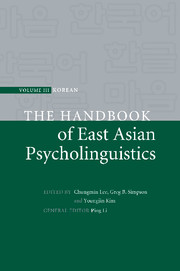Book contents
- Frontmatter
- Contents
- List of figures
- List of tables
- List of contributors
- Preface
- Introduction: Advances in Korean psycholinguistics
- Part I Language acquisition
- Part II Language processing
- 28 Visual processing of Hangul, the Korean script
- 29 English vowel spaces produced and perceived by Americans and Koreans
- 30 Morphological representation and processing of Sino-Korean words
- 31 The role of phonology in word recognition of Korean Hangul and Hanja
- 32 Lexical and sublexical processes in Korean word recognition
- 33 Prosody in sentence processing
- 34 Korean sentence processing
- 35 Sentence processing and memory representation in Korean
- 36 Understanding complex sentences: memory constraints and informational structure
- 37 ERP studies of Korean language processing: word-order effects
- 38 Inferences during discourse comprehension in Korean
- 39 Morpho-syntactic processing in Korean aphasics
- 40 Morpho-syntactic processing of Korean-speaking adults with Broca's aphasia
- 41 Comprehension deficits in Korean agrammatic aphasia
- 42 Developmental reading disorders in Korean
- 43 Individual differences in Korean language processing: context-dependent processing of skilled readers in word ambiguity resolution
- 44 A computational model of lexical and morphological processing in Korean
- References
- Name index
- Subject index
28 - Visual processing of Hangul, the Korean script
from Part II - Language processing
Published online by Cambridge University Press: 05 June 2012
- Frontmatter
- Contents
- List of figures
- List of tables
- List of contributors
- Preface
- Introduction: Advances in Korean psycholinguistics
- Part I Language acquisition
- Part II Language processing
- 28 Visual processing of Hangul, the Korean script
- 29 English vowel spaces produced and perceived by Americans and Koreans
- 30 Morphological representation and processing of Sino-Korean words
- 31 The role of phonology in word recognition of Korean Hangul and Hanja
- 32 Lexical and sublexical processes in Korean word recognition
- 33 Prosody in sentence processing
- 34 Korean sentence processing
- 35 Sentence processing and memory representation in Korean
- 36 Understanding complex sentences: memory constraints and informational structure
- 37 ERP studies of Korean language processing: word-order effects
- 38 Inferences during discourse comprehension in Korean
- 39 Morpho-syntactic processing in Korean aphasics
- 40 Morpho-syntactic processing of Korean-speaking adults with Broca's aphasia
- 41 Comprehension deficits in Korean agrammatic aphasia
- 42 Developmental reading disorders in Korean
- 43 Individual differences in Korean language processing: context-dependent processing of skilled readers in word ambiguity resolution
- 44 A computational model of lexical and morphological processing in Korean
- References
- Name index
- Subject index
Summary
Background
The Korean alphabet and syllables are referred to as Hangul (or Hangeul) in the Republic of Korea (S.), and registered as Jeongeum at ISO. Taylor and Taylor (1983) called Hangul an alphabetic syllabary, because of its dual characteristics of alphabetic script and syllabic script. For example, all of the Hangul syllable blocks (i.e. ‘kulca’ or ‘gulja’ in Korean) should be composed of twenty-four visually distinct letters (fourteen consonants and ten vowels), while Hangul words are usually written and spoken in units of syllable blocks like Hanja (Chinese characters). Before discussing the visual processing of Hangul, we need to understand these dual aspects of Hangul. (Although some terms imply phonemic aspects, this discussion focuses on the visual aspects of Hangul.)
There are fourteen simple Hangul consonant letters including the five visually prototypic consonants (┐, ∟, ⊏, ⋏, and ㅇ) and the others derived from them by adding one to three strokes. These consonant letters can be combined with each other to form another five double consonants and eleven complex consonant letters. The ten simple Hangul vowel letters are derived by combining only three different strokes (·, –, and |). The first of these strokes, the small dot ‘·’, no longer used by itself, is transformed into a short vertical or a short horizontal bar, when added to a long horizontal or a long vertical bar, respectively. These ten simple vowel letters are combined with each other to form eleven compound vowel letters.
- Type
- Chapter
- Information
- The Handbook of East Asian Psycholinguistics , pp. 379 - 389Publisher: Cambridge University PressPrint publication year: 2009
- 2
- Cited by



